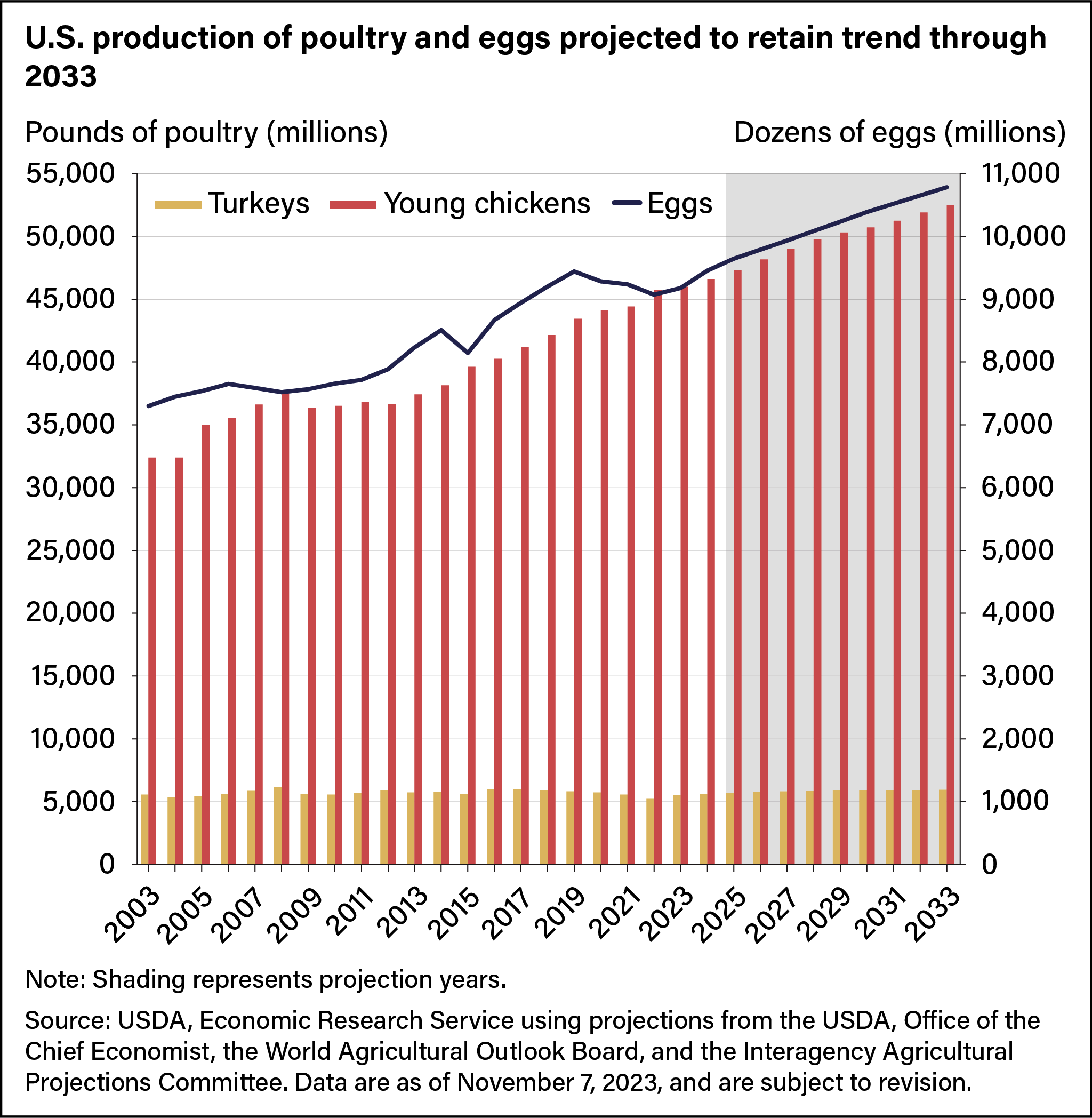



Long-term growth projected as US poultry, egg sector recovers
Poultry is the most consumed animal protein in the USUS poultry and egg production is projected to grow steadily through 2033, after outbreaks of highly pathogenic avian influenza (HPAI) sharply reduced the US poultry and egg-laying flock in 2022 and 2023. USDA’s annual 10-year projections, also known as the US agricultural baseline, provide a long-term outlook for major crop and livestock commodities and are based on specific assumptions. For the poultry and egg sector, assumptions include no more outbreaks of animal disease, a continuation of existing US and global policies and trade agreements, normal weather, and specific macroeconomic conditions, according to a recent USDA ERS market report.
Poultry is the most consumed animal protein in the United States. Broiler and turkey meat accounted for 46% of all red meat and poultry consumption by volume in 2023, with cash receipts of over $50 billion. In addition, the United States is the world’s second largest exporter of chicken behind Brazil. In 2023, nearly 16% of US broiler production was exported. Easing prices for domestic feed, the costliest input in any animal production, are expected to benefit all three main poultry sectors: broilers, eggs, and turkey. Market prices for broilers and eggs are expected to increase moderately over the projection period, while turkey prices are expected to decrease slightly as domestic demand weakens.
The egg sector continues to recover after avian influenza struck the egg-laying flock, with millions of laying hens lost to either the disease or to depopulation. Egg production fell from 9.4 billion dozen in 2019 to a 5-year low of 9.1 billion dozen in 2022. When USDA formulated its agricultural baseline projections in October 2023, highly pathogenic avian influenza (HPAI) cases were relatively low, and egg production had begun to recover. Consistent with the baseline presumption of no further avian influenza outbreaks, US egg production was projected to recover in 2024 and continue to expand to a record 10.8 billion dozen by 2033 as the US population and per capita consumption grew. Projected growth reflects ongoing demand for eggs and egg-containing products—one of the cheapest sources of protein. After the finalization of the baseline projections, a new cluster of outbreaks in late 2023 and early 2024 affected egg production. More recent forecasts for egg production in 2024 are lower, reflecting ongoing challenges but still representing an increase from the previous year. USDA economists continue to monitor cases of the disease and regularly report on changes in production.
The turkey sector also faced disease and other challenges over the past decade. From 2017 to 2022, turkey production declined 12.7% from 6.0 billion pounds to 5.2 billion, the lowest production level this century. The Coronavirus (COVID-19) pandemic temporarily affected the availability of labor for meatpackers and changed the patterns of demand for turkey meat. The sector had not fully recovered by 2022, when more than 9 million turkeys were depopulated as a result of an HPAI outbreak. After seemingly winding down, the outbreak returned for a second wave, becoming the largest outbreak of HPAI in US history in terms of total poultry losses. Consumer demand for turkey has weakened, and production has been restrained. With the assumption that the avian flu’s effects had run their course, USDA’s long-term outlook projected turkey production to grow 14% by 2033 from the depressed levels in 2022, reaching 6.0 billion pounds. Even so, per capita consumption is expected to continue its downward trend.
Broiler production weathered the pandemic and avian influenza challenges of the last few years without experiencing the dramatic drops that affected turkey and egg production. The annual growth in broiler production remained positive through both the pandemic and the avian influenza outbreak, although the annual growth rate dropped below 1% in 2021 and 2023. Broilers are produced primarily in the Southeast United States, which wasn’t as heavily impacted by the HPAI outbreak. Broilers also typically require only 7 weeks from hatching to slaughter and are less susceptible to avian influenza than older laying hens and turkeys, which are raised at least twice as long as broilers before slaughter. Chicken production is projected to grow from 45.7 billion pounds in 2022 to 52.5 billion pounds in 2033, surpassing previous records each year, as feed prices retreat from recent highs and the number of broilers processed continues to trend upward.










